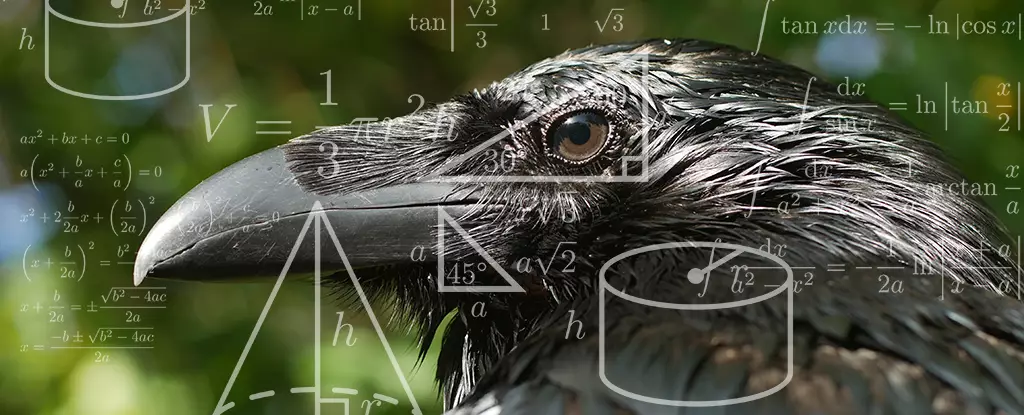Crows have always been fascinating creatures, popularly dismissed as mere scavengers. Yet, a recent study unveils an astonishing layer to their intellect that shatters common perceptions. While most of us have associated mathematical reasoning and geometric intelligence exclusively with humans, research from the University of Tübingen now reveals that these avian wonders possess a striking ability to recognize geometric regularities akin to our own. Not only does this challenge our understanding of intelligence in the animal kingdom, but it also compels us to reconsider the evolutionary milestones that govern behavioral sophistication.
In a world that often prides itself on human superiority, the revelation that crows can identify the ‘odd one out’ in geometric shapes should be a moment of reckoning. The implications of such cognitive abilities extend far beyond a single experiment; they question the narratives we’ve constructed about intelligence, evolution, and even our relationship with the natural world.
Scientific Discovery and its Far-Reaching Implications
The research, led by animal physiologist Andreas Nieder, involved two male carrion crows trained to pinpoint a geometric intruder among a set of seemingly homogeneous shapes. The experiment methodically showcased the crows’ prowess in recognizing regularity within groups of quadrilaterals, demonstrating their inherent sense of geometry. As the crows navigated through their tasks, they were remarkably adept at finding the outlier in a variety of configurations, prompting a fascinating reflection on the cognitive abilities of non-human entities.
In an age where artificial intelligence mimics facets of human cognition, the crow’s innate geometric acumen presents a paradigm shift. This research propels crows into a category of beings that not only survive but thrive, utilizing evolved instincts for complex reasoning—a stark contrast to the antiquated view of animal intelligence as purely instinctual. What does it mean for humanity when a bird can intuitively understand geometric relationships as well as, if not better than, some people do? The fact that crows perform these tasks without training highlights that cognitive sophistication could exist across the animal kingdom in forms we have yet to fully comprehend.
The Intersection of Geometry and Evolution
The evolutionary implications of this study are profound. By recognizing geometric regularities, crows reinforce the idea that advanced cognitive traits may have deeper roots than we believe. Traditional Darwinian thought often frames intelligence as an exclusively human feature. However, this emerging narrative underscores the necessity to reevaluate the evolutionary timeline itself, suggesting that the cognitive tools we consider uniquely human may indeed be present in various forms across species.
Nieder asserts that the capacity for spatial awareness and geometric intuition in birds offers them a survival advantage, guiding their navigation in complex environments. This assertion aligns with the broader understanding of intelligence as a spectrum rather than a binary characteristic confined to human beings. As we delve deeper into the cognitive abilities of animals like crows, we are compelled to confront our biases and preconceived hierarchies.
A New Perspective on Animal Behavior
Crows’ abilities reveal an intricate tapestry of intelligence that interlink spatial awareness, environmental navigation, and survival instincts. This understanding should spark curiosity rather than disdain. As our species grapples with pressing social and environmental crises, the mastery displayed by crows challenges us to expand our empathy and recognition of other life forms. We are not alone on this planet, nor should we regard all other species merely as resources or attributes of our supremacy.
Moreover, the capacity for geometric reasoning in crows reveals a truth that demands our attention: the subtleties of intelligence manifest in diverse forms. Instead of relegating the study of animal cognition to the fringes of scientific inquiry, we must elevate its status, integrating it into our conversations around environmental ethics and biodiversity. The cognitive complexities within avian species can serve as a microcosm for understanding broader ecological relationships and deepening our appreciation for the multifaceted web of life.
In summation, the exploration of crows’ geometric intuition is not purely an academic endeavor; it serves as a profound reminder of the intelligence that permeates our natural world. Crows exemplify the marvels of evolution, urging us to dismantle our anthropocentric views and heralding a shift towards a richer understanding of the intelligence in our cohabitating species. Rather than considering these revelations as challenges to human exceptionalism, we should embrace them as invitations to marvel at the extraordinary capabilities of the creatures with whom we share this planet.



Leave a Reply